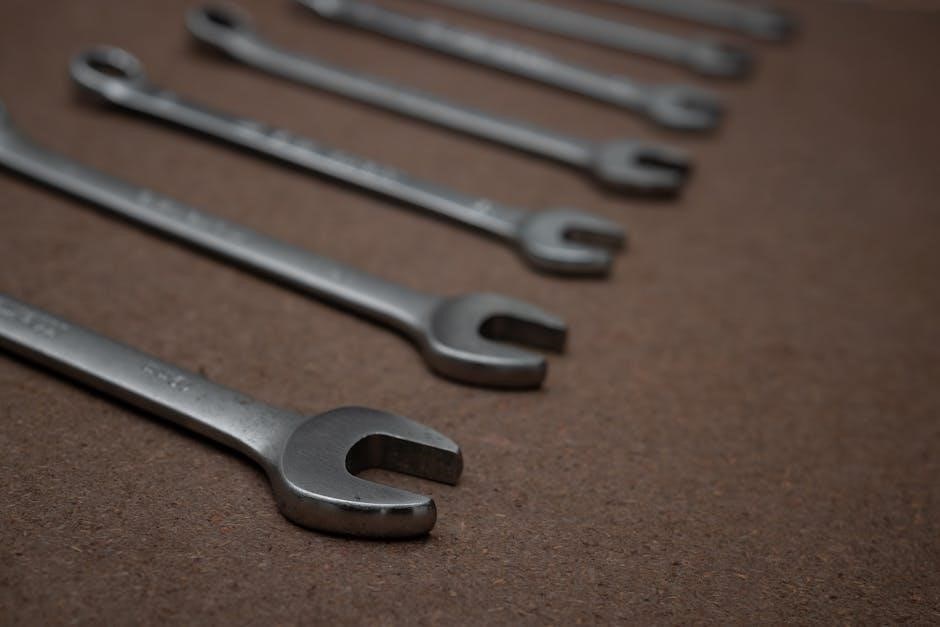shop vac user manual

Welcome to the Shop Vac User Manual! This guide helps you understand and effectively use your Shop Vac for cleaning tasks. Learn safety, assembly, operation, and maintenance tips to maximize efficiency and longevity.
1.1 What is a Shop Vac?
A Shop Vac is a versatile wet/dry vacuum designed for heavy-duty cleaning in workshops, garages, and industrial spaces. It excels at picking up dust, debris, and liquids, making it essential for maintaining clean work environments. Known for its powerful suction and durability, a Shop Vac is a must-have tool for professionals and DIYers alike, offering practical solutions for various cleaning challenges.
1.2 Importance of Reading the User Manual
Reading the user manual is essential for safe and effective use of your Shop Vac. It provides critical safety guidelines, assembly instructions, and operation tips. Understanding proper usage ensures optimal performance, prevents damage, and extends the product’s lifespan. The manual also helps troubleshoot common issues, saving time and effort. By following the guidelines, you can maximize efficiency and maintain your Shop Vac for long-term reliability and satisfaction.

Safety Precautions
Always follow safety guidelines to avoid accidents. Ensure proper electrical connections, avoid overheating, and handle hazardous materials carefully. Wear protective gear and keep the area clear.
2.1 General Safety Guidelines
Always wear protective gear like gloves and safety glasses when using your Shop Vac. Ensure the area is well-ventilated to avoid inhaling dust. Keep loose clothing tied back and avoid overreaching. Never use the vacuum near open flames or sparks. Store the device in a dry, cool place. Regularly inspect cords and hoses for damage. Keep children and pets away during operation. Follow all safety precautions to prevent accidents and ensure safe usage.
2.2 Electrical Safety Tips
Always use your Shop Vac on a grounded electrical outlet to prevent shocks. Avoid overloading circuits and keep cords away from water. Never operate the device near puddles or with wet hands. Regularly inspect cords for damage and replace them if worn. Ensure the vacuum is turned off before unplugging or plugging in. Use surge protectors for added safety. Follow all electrical guidelines to minimize risks and ensure safe operation.
2.3 Handling Hazardous Materials
When handling hazardous materials, ensure your Shop Vac is equipped with a HEPA filter or specialized cartridge. Always operate in wet mode for liquids. Avoid vacuuming flammable or corrosive substances. Wear protective gear, including gloves and goggles. Dispose of collected hazardous waste according to local regulations. Never mix different types of waste in the tank. Regularly clean and decontaminate the vacuum after handling hazardous materials to prevent residue buildup and ensure safe operation.
Assembly and Initial Setup
Begin by unpacking and inventorying all parts. Attach accessories like hoses and nozzles securely. Connect the power source carefully, ensuring all components are properly aligned and plugged in safely.
3.1 Unpacking and Inventory
Exciting to receive your Shop Vac! Carefully unpack the unit and verify all components. Typically included are the main vacuum, hose, extension wands, nozzles, filters, and accessories. Check each item against the provided list to ensure nothing is missing. Inspect for damage and refer to the manual for descriptions of each part. This step ensures you’re ready for assembly and operation.
3.2 Attaching Accessories
Attaching accessories to your Shop Vac is essential for optimal performance. Ensure all parts are compatible with your model. Align the accessory with the port, then twist and lock firmly. Secure connections prevent leaks and maintain suction power. For hoses or wands, check for a snug fit. Always refer to the manual for specific attachment guidelines to avoid damage or improper function.
3.3 Connecting the Power Source
To connect the power source, ensure the Shop Vac is unplugged. Locate a grounded electrical outlet matching the vacuum’s voltage requirements. Plug in the power cord securely, avoiding extension cords if possible. Before turning it on, verify all connections are tight and the cord is undamaged. If unsure, consult a professional to ensure safe operation.
Operating Instructions

Plug in the Shop Vac, press the power button to start. Adjust suction control as needed. Use appropriate attachments for different surfaces. Empty the dustbin when full.
4.1 Turning On and Off
To operate your Shop Vac, locate the power switch, typically on the top or side. Ensure the area is clear of debris before turning it on. Press the switch to start, and let it run until the task is complete. To turn it off, press the switch again and unplug it for safety. Always allow the motor to cool before storing. Regular maintenance ensures smooth operation.

4.2 Adjusting Suction Power
Adjusting the suction power on your Shop Vac allows you to customize cleaning efficiency for different tasks. Use the variable speed control dial or switch to increase or decrease power. For lighter debris, lower settings suffice, while higher settings are ideal for heavy-duty cleaning. Ensure the filter is clean for optimal performance. Adjusting suction power helps conserve energy and reduces noise levels during operation.
4.3 Using Different Attachments
Explore various attachments to enhance your Shop Vac’s versatility. Use crevice tools for tight spaces, brush nozzles for delicate surfaces, and wet suction nozzles for liquids. Attachments like extension wands and upholstery brushes help tackle diverse cleaning tasks. Always secure attachments firmly to ensure proper function and safety. Experiment with different combinations to optimize cleaning efficiency for specific jobs, from dusting to heavy-duty messes.

Maintenance and Troubleshooting
Regularly clean filters, check for blockages, and empty the tank to ensure optimal performance. Address common issues like reduced suction by inspecting hoses and connections for damage.
5.1 Cleaning the Filter
Regularly cleaning the filter is essential for maintaining your Shop Vac’s performance. Turn off and unplug the device before starting. Remove the filter and gently tap it to eliminate dust and debris. For wet/dry vacuums, rinse the filter with water if recommended. Allow it to dry completely before reinstalling. A clean filter ensures optimal suction power and prevents motor damage. Replace the filter if damaged or worn out for consistent efficiency.
5.2 Replacing Parts
Regularly inspect your Shop Vac for worn-out parts. Replace filters, hoses, or brushes as needed to maintain performance; Always use genuine replacement parts for compatibility. Turn off and unplug the device before starting any replacement. Refer to the manual for disassembly instructions. Properly dispose of old parts to minimize environmental impact. Keep extra parts on hand to avoid downtime during cleaning tasks.
5.3 Common Issues and Solutions
Addressing common issues ensures optimal performance. Clogged hoses can be cleared by disconnecting and cleaning them. Reduced suction may indicate a dirty filter, which should be cleaned or replaced. If the motor overheats, turn it off and let it cool. For excessive noise, check for blockages or loose parts. Regular maintenance, like emptying the tank and checking for damage, prevents many issues. Refer to the troubleshooting guide for detailed solutions.

Accessories and Attachments
Explore various nozzles, brushes, and extension wands to enhance cleaning efficiency. Optional accessories like crevice tools and dusting brushes provide versatility for different cleaning tasks.
6.1 Types of Nozzles and Brushes
Your Shop Vac comes with various nozzles and brushes designed for specific tasks. The crevice nozzle is ideal for tight spaces, while the upholstery brush gently cleans fabrics. A wet nozzle is perfect for liquid cleanup, and the soft-bristle brush is great for delicate surfaces. Hard-bristle brushes tackle tough debris. Each attachment enhances cleaning efficiency, ensuring versatility for different surfaces and messes. Choose the right tool for the job to achieve optimal results.
6.2 Using Extension Wands
Extension wands are essential for reaching distant or hard-to-access areas. Attach the wand to the hose securely, ensuring a tight fit to maintain suction power. Use the wand to extend your cleaning range, especially for ceilings, stairs, or large spaces. Always check for damage before use and clean the wand regularly to prevent dust buildup. This accessory enhances versatility, making your Shop Vac more efficient for various cleaning tasks.
6.3 Optional Accessories
Enhance your Shop Vac’s functionality with optional accessories like crevice tools, upholstery brushes, and extension wands. These additions allow for detailed cleaning in tight spaces and on various surfaces. Optional filters, such as HEPA or wet/dry filters, improve performance for specific tasks. Additional hoses or remote-controlled nozzles can also be purchased for convenience. Explore these extras to tailor your Shop Vac to your cleaning needs.

Noise Reduction and Optimization
Minimize noise and optimize performance by using a noise diffuser, maintaining proper suction settings, and ensuring all parts are in good working condition for efficient operation.
7.1 Reducing Operational Noise
To minimize noise while using your Shop Vac, ensure proper maintenance, such as cleaning or replacing the filter. Check for blockages in hoses or attachments, as obstructions can increase noise. Use the correct attachments for the task, as improper ones may cause vibration. Place the Shop Vac on a stable, soft surface to reduce vibration noise. Operate at lower suction settings when possible and schedule cleaning during less busy times. Wearing ear protection is also recommended. Regularly inspect and tighten loose parts, as rattling components can contribute to noise. Ensure the motor is well-ventilated to prevent overheating, which may increase operational noise. By following these tips, you can significantly reduce the noise level of your Shop Vac during operation.
7.2 Optimizing Suction Efficiency
Maximize your Shop Vac’s performance by ensuring the filter is clean and free of debris. Regularly inspect and clear blockages in the hose or wand. Use the correct attachments for the task to maintain optimal airflow. Keep the tank or dustbin empty to avoid reducing suction power. Properly seal all connections to prevent air leaks, which can lower efficiency. Regular maintenance ensures consistent and powerful suction for effective cleaning.
Storage and Portability
Properly store your Shop Vac in a dry, clean area. Regularly clean the device before storage to prevent dust buildup. Use the integrated handle for easy portability and transport.
8.1 Proper Storage Techniques
Store your Shop Vac in a dry, cool place to prevent damage. Ensure the tank is empty and clean before storage. Secure the hose and accessories neatly to avoid tangling. Check for any damage or wear and tear. Store the unit upright to maintain balance and prevent leakage. Regularly inspect stored parts for dust or moisture buildup. Proper storage extends the lifespan and maintains efficiency of your Shop Vac.
8.2 Transporting the Shop Vac
When transporting your Shop Vac, ensure it is securely placed in your vehicle to prevent movement. Use straps or ropes to tie it down, protecting the hose and accessories from damage. Always check for any loose parts before transport and ensure the tank is empty to avoid spills. For wet/dry models, drain all fluids beforehand. Consider using a cart or dolly for easier mobility. Check local regulations for disposal guidelines if transporting waste.

Comparison with Other Vacuums
Shop Vacs excel in heavy-duty cleaning, offering superior suction power and durability compared to household vacuums, making them ideal for workshops and industrial settings.
9.1 Wet vs. Dry Vacuums
Shop Vacs are versatile, handling both wet and dry debris. Wet vacuums are designed for liquids, featuring a float valve to prevent motor damage. Dry vacuums excel at solid particles, often with HEPA filters for allergens. Choose the right type based on your cleaning needs for optimal performance and safety.
9.2 Shop Vac vs. Household Vacuums
Shop Vacs are designed for heavy-duty cleaning in workshops or garages, handling wet and dry debris. Unlike household vacuums, they offer higher suction power and larger capacity. Household vacuums are lightweight, designed for indoor use, and typically handle smaller, dry debris. Shop Vacs are more versatile for tough cleaning tasks, while household vacuums focus on everyday home maintenance.

Environmental Considerations
Proper disposal of collected waste and using energy-efficient settings help minimize environmental impact. Regular filter maintenance also enhances performance and reduces energy consumption.
10.1 Disposal of Waste
Properly dispose of waste collected by your Shop Vac to minimize environmental impact. Separate debris, liquids, and hazardous materials. Check local regulations for disposal guidelines. Empty the tank responsibly, ensuring no harmful substances enter waterways. For hazardous materials, use sealed containers and designated facilities. Always follow safety protocols to prevent contamination and environmental harm. Regularly clean and maintain your Shop Vac to ensure optimal performance and waste management efficiency.
10.2 Energy Efficiency
Energy efficiency is crucial for reducing power consumption while maintaining performance. Modern Shop Vacs often feature eco-friendly designs, such as variable speed controls and optimized motors, to minimize energy use. Regular maintenance, like cleaning filters, ensures the unit runs efficiently. Using the correct settings for tasks helps conserve energy without compromising suction power, making it environmentally friendly and cost-effective.

Warranty and Support
Your Shop Vac is backed by a comprehensive warranty. For inquiries or issues, contact our dedicated support team or visit our official help center for assistance.
11.1 Understanding the Warranty
Your Shop Vac is backed by a comprehensive warranty designed to protect your investment. The warranty period varies by model and typically covers defects in materials and workmanship. Register your product to ensure full coverage and access to support services. Review the warranty terms to understand what is included and any conditions that may void it. Proper maintenance, as outlined in this manual, is essential to uphold warranty validity.
11.2 Contacting Customer Support
For assistance, visit the official Shop Vac website or call their customer support hotline. Provide your product model and serial number for efficient service. Support is available Monday-Friday, 8 AM-5 PM EST. You can also submit inquiries via email or live chat. Additionally, YouTube offers helpful tutorials and troubleshooting guides for Shop Vac users, accessible through their help center.
User Reviews and Feedback
Users praise the Shop Vac’s powerful suction and durability. Some note noise levels and filter maintenance as minor drawbacks. Experienced users recommend regular filter cleaning and using genuine accessories for optimal performance;
12.1 Common User Experiences
Users often find the Shop Vac reliable for heavy-duty cleaning tasks. Many appreciate its ease of setup and versatility in handling both wet and dry debris. The portability and adjustable suction settings are frequently praised. Some users note that regular filter maintenance is essential for optimal performance. Overall, the Shop Vac is well-regarded for its durability and effectiveness in various cleaning scenarios, making it a popular choice for workshops and homes alike.
12.2 Tips from Experienced Users
- Regularly clean the filter to maintain suction power.
- Use the correct attachments for different surfaces.
- Empty the tank before it’s full to avoid spills.
- Store accessories in a designated bag for easy access.
- Check for blockages in hoses or nozzles if suction weakens.
- Disconnect the power source before performing maintenance.
Future Trends in Shop Vac Technology
Advancements include smart sensors, energy-efficient motors, and integration with smart home systems, enhancing performance and user convenience for future Shop Vac models.
13.1 Advances in Suction Power
Recent advancements in suction power technology have significantly enhanced Shop Vac performance. Innovations include improved motor designs, optimized fan blades, and advanced airflow systems, which collectively increase efficiency. Lightweight, durable materials further contribute to better suction without adding bulk. Additionally, features like variable speed controls and smart sensors enable automatic adjustment, ensuring optimal cleaning results across various surfaces and debris types.
13.2 Integration with Smart Technology
Future Shop Vac models may integrate with smart technology, allowing users to control settings via smartphone apps. Voice commands through smart assistants could enable hands-free operation. Advanced sensors might monitor performance and optimize suction power. This seamless connectivity enhances convenience and efficiency, making cleaning tasks easier and more adaptable to modern lifestyles.
This concludes the Shop Vac User Manual. Proper usage and maintenance ensure optimal performance and longevity. Refer to the manual for any future troubleshooting or adjustments.
14.1 Summary of Key Points
This manual provides essential guidance for using your Shop Vac effectively. It covers safety precautions, assembly, operation, and maintenance. Key points include proper setup, suction power adjustment, and troubleshooting common issues. Regular filter cleaning and accessory usage are emphasized for optimal performance. By following these guidelines, you can ensure efficient cleaning, prolong the lifespan of your Shop Vac, and maintain a safe working environment. Always refer to the manual for specific instructions.
14.2 Final Tips for Effective Use
For optimal performance, regularly maintain your Shop Vac by cleaning filters and checking for blockages. Always empty the tank before storage to prevent moisture buildup. Use appropriate attachments for different surfaces to avoid damage. Store the unit in a dry, cool place, and keep the hose organized to prevent kinks. Refer to the manual for complex tasks to ensure safety and efficiency.
Leave a Reply
You must be logged in to post a comment.